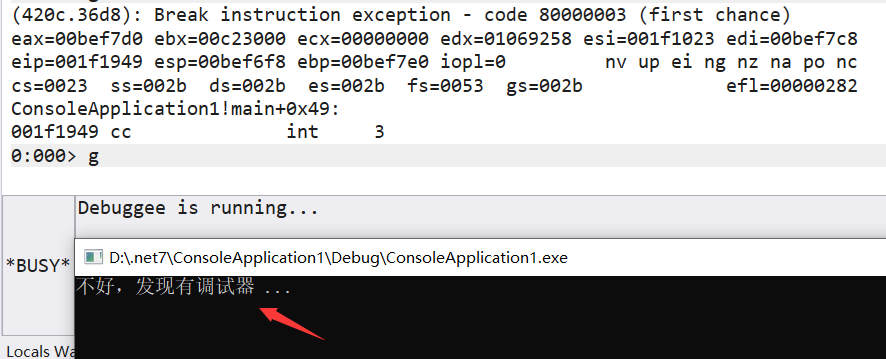一:背景
1.讲故事
前段时间有位朋友找到我,说他的程序在客户的机器上跑着跑着会出现偶发卡死,然后就崩掉了,但在本地怎么也没复现,dump也抓到了,让我帮忙看下到底怎么回事,其实崩溃类的dump也有简单的,也有非常复杂的,因为大多情况下都是非托管层面出现的各种故障,非常考验对 C, C++, Win32 API 以及 汇编 的理解,所以能不能解决看运气吧, 不管怎么说,先上 WinDbg。
二:WinDbg分析
1. 查找崩溃点
WinDbg 非常牛的地方在于它拥有一个自动化崩溃分析命令 !analyze -v,它的输出信息非常有参考价值,所以尝试一下看看。
0:136> !analyze -v
*******************************************************************************
* *
* Exception Analysis *
* *
*******************************************************************************
CONTEXT: (.ecxr)
eax=00000000 ebx=00000000 ecx=00000000 edx=00000000 esi=00000003 edi=00000003
eip=777cf04c esp=22dfd678 ebp=22dfd808 iopl=0 nv up ei pl nz na pe nc
cs=0023 ss=002b ds=002b es=002b fs=0053 gs=002b efl=00000206
ntdll!NtWaitForMultipleObjects+0xc:
777cf04c c21400 ret 14h
Resetting default scope
EXCEPTION_RECORD: (.exr -1)
ExceptionAddress: 0174ba6d
ExceptionCode: 00000000
ExceptionFlags: 00000000
NumberParameters: 0
PROCESS_NAME: xxx.exe
STACK_TEXT:
22dfd808 75b23b10 00000003 22dfdc68 00000001 ntdll!NtWaitForMultipleObjects+0xc
22dfd808 75b23a08 00000003 22dfdc68 00000000 KERNELBASE!WaitForMultipleObjectsEx+0xf0
22dfd824 672ff11a 00000003 22dfdc68 00000000 KERNELBASE!WaitForMultipleObjects+0x18
22dfdca4 672ff3ac 672dd150 672d0000 00000003 Faultrep!WerpReportFaultInternal+0x59e
22dfdcc4 672dd17d 22dfdcec 708d0479 22dfdd60 Faultrep!WerpReportFault+0x9e
22dfdccc 708d0479 22dfdd60 00000000 22dfdd60 Faultrep!ReportFault+0x2d
22dfdcec 708d07e9 ec030e28 1c8f7728 00000003 clr!DoReportFault+0x43
22dfdd44 709f3c7e 00000003 22dfe140 2e954594 clr!WatsonLastChance+0x19a
22dfe090 709f3d90 ec0333f0 22dfe140 2e954594 clr!DoWatsonForUserBreak+0xc2
22dfe120 6fdc690f 00000000 00000000 00000000 clr!DebugDebugger::Break+0xc9
22dfe148 0174ba6d 00000000 00000000 00000000 mscorlib_ni!System.Diagnostics.Debugger.Break+0x57
WARNING: Frame IP not in any known module. Following frames may be wrong.
22dfe194 0174b58b 00000000 00000000 00000000 0x174ba6d
22dfe1e8 0174b525 00000000 00000000 00000000 mscorlib_ni!System.Runtime.CompilerServices.AsyncTaskMethodBuilder.Start<<xxxAsync>d__10>+0x43
22dfe1e8 0174b525 00000000 00000000 00000000 mscorlib_ni!System.Runtime.CompilerServices.AsyncTaskMethodBuilder.Start<<xxxAsync>d__10>+0x43
22dfe22c 0174b3bd 00000000 00000000 00000000 0x174b525
22dfe27c 0174b33b 00000000 00000000 00000000 0x174b3bd
22dfe2d0 0174b2d5 00000000 00000000 00000000 0x174b33b
...
SYMBOL_NAME: faultrep!WerpReportFaultInternal+59e
MODULE_NAME: Faultrep
IMAGE_NAME: Faultrep.dll
STACK_COMMAND: ~136s; .ecxr ; kb
...
从卦中的调用栈看,有二个非常重要的信息。
- Debugger.Break()
这个是 C# 对 int 3 的封装,即 断点中断异常,目的就是将程序的所有线程中断。
- Faultrep!ReportFault()
这个是 WER 2.0 ,全称为 Windows Error Reporting Service,用来抓崩溃dump的,前身是 Waston 医生,在 Windows 服务列表中可以看到。

还有一点, Faultrep.dll 是 WER 的一个组件,会在抓取过程中自动加载,我们用 lm 观察进程中的 dll 列表。
0:136> lm
start end module name
00fe0000 01034000 xxx C (service symbols: CLR Symbols without PDB)
0c100000 0c123000 WINMMBASE (deferred)
662d0000 662ef000 clrcompression (deferred)
672d0000 67327000 Faultrep (pdb symbols) c:mysymbolsFaultRep.pdbE16126C7FB9849A8B9AC57D8D62CABB01FaultRep.pdb
...
汇总以上信息,大概就能推测出代码中用了 Debugger.Break() 函数,因为无catch处理,Windows 启动了 WER 2.0,程序代码在 ntdll!NtWaitForMultipleObjects 处等待第三方组件处理完毕,因为各种原因出现了问题导致无法返回最后崩溃。
通过卦中的信息我们大概知道了前因后果,但代码中为什么会出现 Debugger.Break() 呢?这就需要我们继续深挖。
2. 为什么会有 Debugger.Break()
刚才的输出中有这么一段话: STACK_COMMAND: ~136s; .ecxr ; kb ,它可以让我们找到异常前的调用栈,为了能看到托管栈,这里将 kb 改成 !clrstack 。
0:136> ~136s; .ecxr ; !clrstack
OS Thread Id: 0x13ec (136)
Child SP IP Call Site
22dfe0ac 777cf04c [HelperMethodFrame: 22dfe0ac] System.Diagnostics.Debugger.BreakInternal()
22dfe128 6fdc690f System.Diagnostics.Debugger.Break() [f:ddndpclrsrcBCLsystemdiagnosticsdebugger.cs @ 65]
22dfe150 0174ba6d xxx.xxx+d__10.MoveNext()
22dfe19c 0174b58b System.Runtime.CompilerServices.AsyncTaskMethodBuilder.Start[[xxx.xxx+d__10, xxx.Abstractions]](d__10 ByRef) [f:ddndpclrsrcBCLsystemruntimecompilerservicesAsyncMethodBuilder.cs @ 316]
22dfe1f0 0174b525 xxx.xxxAsync(System.String, System.String)
22dfe238 0174b3bd xxx.xxxProducer+d__7.MoveNext()
22dfe284 0174b33b System.Runtime.CompilerServices.AsyncTaskMethodBuilder.Start[[xxx.xxx+d__7, xxx.Abstractions]](d__7 ByRef)
22dfe2d8 0174b2d5 xxx.xxx.xxx(System.String, System.String)
从卦中看,貌似是在一个异步方法中手工调用了 Deubgger.Break() 方法,接下来我们观察下源码,由于比较隐私,这里就简化一下。
internal async Task xxxAsync(string x1, string x2)
{
if (string.IsNullOrEmpty(x1))
{
Debugger.Break();
return;
}
if (string.IsNullOrEmpty(x2))
{
Debugger.Break();
return;
}
...
}
这代码果然有意思,在防御性编程中居然用 Debugger.Break() 来处理,比较少见。
找到了问题源头,解决方法就简单了,大概有两种做法。
- 去掉
Debugger.Break()语句 - 关闭 WER 2.0 服务

3. 对 Debugger.Break() 的题外话
在 clr 源码中有对 Debugger.Break() 非常详细的注释。
// This does a user break, triggered by System.Diagnostics.Debugger.Break, or the IL opcode for break.
//
// Notes:
// If a managed debugger is attached, this should send the managed UserBreak event.
// Else if a native debugger is attached, this should send a native break event (kernel32!DebugBreak)
// Else, this should invoke Watson.
//
// Historical trivia:
// - In whidbey, this would still invoke Watson if a native-only debugger is attached.
// - In arrowhead, the managed debugging pipeline switched to be built on the native pipeline.
FCIMPL0(void, DebugDebugger::Break)
{
...
}
FCIMPLEND
注释文本: Else, this should invoke Watson 中的 Watson 其实就是本篇聊到的 WER,观察反汇编其实就是对 int 3 的封装。
0:136> uf kernelBase!DebugBreak
KERNELBASE!DebugBreak:
75ba5e40 8bff mov edi,edi
75ba5e42 cc int 3
75ba5e43 c3 ret
在很多反调试机制中,经常会用 int 3 来检测当前程序是否被附加了调试器,参考如下 C++ 代码。
#include <iostream>
int isAttach = 0;
int main()
{
__try
{
__asm {
int 3
}
isAttach = 1;
}
__except(1)
{
isAttach = 0;
}
if (isAttach) {
printf("不好,发现有调试器 ...");
}
else {
printf("哈哈,一切正常!");
}
getchar();
}
如果你用 WinDbg 附加上去, 就会被程序检测到,截图如下:

如果是正常运行,会是如下界面

可以在 C# 中通过 Pinvoke 引入,这种动态方式,反反调试会有不小的难度。
三:总结
这次事故是朋友在开发过程中为了方便调试,使用了 Debugger.Break() 方法,但在生产环境下并没有删除,导致在某些客户机器上因为 WER 的开启,被 Waston 捕获导致的事故。

